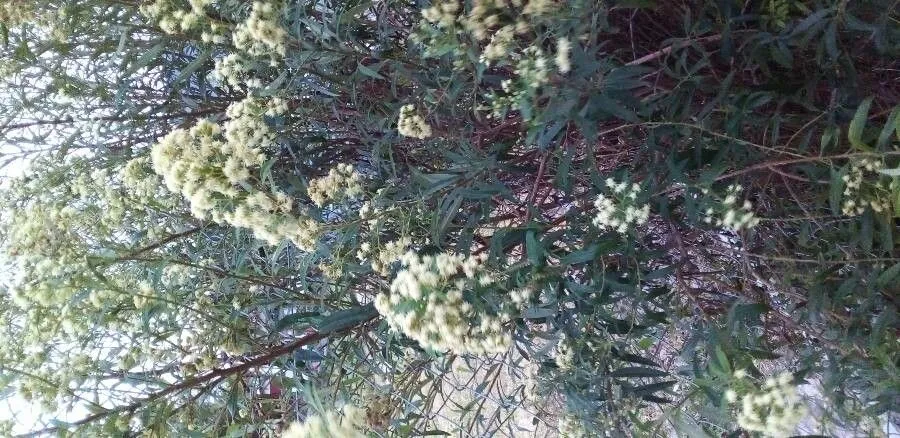
Author: DC.
Bibliography: Prodr. 5: 421 (1836)
Year: 1836
Status: accepted
Rank: species
Genus: Baccharis
Vegetable: False
Observations: Peru to Brazil and N. Argentina
Alecrim, scientifically known as Baccharis dracunculifolia, is a distinctive herbaceous plant notable for its broad geographical distribution and its valuable properties. This plant, categorized under the Asteraceae family, thrives from Peru through Brazil and extends to Northern Argentina, highlighting its adaptability to various climatic and soil conditions within this expansive region.
Discovered and classified in 1836, Baccharis dracunculifolia was described in the botanical literature “Prodr. 5: 421” by the renowned botanist DC. (Augustin Pyramus de Candolle). Since its description, it has garnered considerable interest due to its various applications and benefits.
Alecrim is recognized for its robust foliage and bushy appearance, often reaching considerable heights, which makes it a prominent feature in the landscapes it inhabits. The plant has been the subject of numerous studies, particularly for its medicinal and ecological importance. Traditional uses among indigenous populations and local communities include the application of its extracts for therapeutic purposes, thanks to its anti-inflammatory, antimicrobial, and antiseptic properties.
In addition to its medicinal attributes, Baccharis dracunculifolia plays a crucial ecological role. It contributes to the stability and health of the ecosystems where it grows, offering habitats and nourishment to a variety of insect species. Its presence in diverse environments, from lowland tropics to highland savannas, underscores its resilience and ecological versatility.
In conclusion, Alecrim (Baccharis dracunculifolia) is more than just a plant; it is a vital natural resource with significant ecological and medicinal value. Its widespread occurrence from Peru to Brazil and Northern Argentina attests to its adaptability and the important role it plays in both natural and human-influenced landscapes.
En: Alecrim
Pt: Alecrim do campo, Alecrim-de-vassoura, Cilca (3), Vassoura, Vassoureira (SC), Vassourinha, Alecrim-do-campo
Qu: T’ula
Wo: Doktor
Taken Dec 17, 2015 by Thiago Flores Flores (cc-by-sa)
Taken Mar 19, 2022 by Gonçalves da Cunha Lucas (cc-by-sa)
Taken Sep 22, 2021 by Pazzini Shely (cc-by-sa)
Taken Apr 8, 2021 by Trap Hers (cc-by-sa)
Taken Mar 10, 2020 by JP Corrêa Carvalho (cc-by-sa)
Taken Jul 10, 2022 by Muzzachiodi Norberto (cc-by-sa)
Taken Feb 23, 2022 by Danilo Golovchenko (cc-by-sa)
Taken Apr 8, 2021 by Trap Hers (cc-by-sa)
Taken Feb 28, 2022 by Trap Hers (cc-by-sa)
Taken Dec 10, 2021 by Felipe Domingos de Souza Felipe (cc-by-sa)
Taken Nov 24, 2015 by Thiago Flores Flores (cc-by-sa)
Taken Nov 24, 2015 by Thiago Flores Flores (cc-by-sa)
Taken Nov 24, 2015 by Thiago Flores Flores (cc-by-sa)
Taken Dec 17, 2015 by Thiago Flores Flores (cc-by-sa)
Taken Dec 20, 2021 by Lopes Filipe (cc-by-sa)
Taken May 3, 2022 by Muzzachiodi Norberto (cc-by-sa)
Taken Nov 24, 2015 by Thiago Flores Flores (cc-by-sa)
Taken Nov 24, 2015 by Thiago Flores Flores (cc-by-sa)
Taken Nov 24, 2015 by Thiago Flores Flores (cc-by-sa)
Taken Aug 5, 2021 by Muzzachiodi Norberto (cc-by-sa)
Taken Aug 21, 2022 by Muzzachiodi Norberto (cc-by-sa)
Family: Myrtaceae Author: (F.Muell.) K.D.Hill & L.A.S.Johnson Bibliography: Telopea 6: 402 (1995) Year: 1995 Status:…
Family: Rubiaceae Author: Pierre ex A.Froehner Bibliography: Notizbl. Bot. Gart. Berlin-Dahlem 1: 237 (1897) Year:…
Family: Sapindaceae Author: Koidz. Bibliography: J. Coll. Sci. Imp. Univ. Tokyo 32(1): 38 (1911) Year:…
Family: Asteraceae Author: A.Gray Bibliography: Pacif. Railr. Rep.: 107 (1857) Year: 1857 Status: accepted Rank:…
Family: Fabaceae Author: Medik. Bibliography: Vorles. Churpfälz. Phys.-Ökon. Ges. 2: 398 (1787) Year: 1787 Status:…
Family: Aspleniaceae Author: (Cav.) Alston Bibliography: Bull. Misc. Inform. Kew 1932: 309 (1932) Year: 1932…